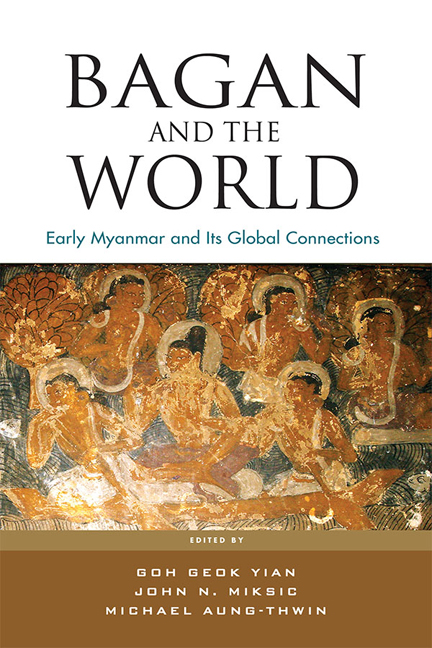Book contents
- Frontmatter
- Contents
- Preface
- Contributors
- 1 Keynote: The Myth of “Splendid Isolation”
- 2 Analysis of Construction Technologies in Pyu Cities and Bagan
- 3 Khraung-kaik Pitaka-taik: 16th-Century Repositories for Buddhist Scriptures in Mrauk-U
- 4 Religious Symbols as Decorations on the Sikhara of Ancient Monuments in the Late Bagan Period
- 5 The Viṣṇu on Garuḍa from the Nat Hlaung Kyaung Temple, Bagan
- 6 A Thousand Years before Bagan: Radiocarbon Dates and Myanmar's Ancient Pyu Cities
- 7 Ta Mok Shwe-Gu-Gyi Temple Kyaukse and Bagan
- 8 Silver Links! Bagan–Bengal and Shadowy Metal Corridors: 9th to 13th Centuries
- 9 Positioning Bagan in the Buddhist Ecumene: Myanmar's Trans-Polity Connections
- 10 Orthogeneity, Settlement Patterns and Earthenware Pottery Distribution in Bagan
- Index
- Miscellaneous Endmatter
2 - Analysis of Construction Technologies in Pyu Cities and Bagan
Published online by Cambridge University Press: 01 February 2018
- Frontmatter
- Contents
- Preface
- Contributors
- 1 Keynote: The Myth of “Splendid Isolation”
- 2 Analysis of Construction Technologies in Pyu Cities and Bagan
- 3 Khraung-kaik Pitaka-taik: 16th-Century Repositories for Buddhist Scriptures in Mrauk-U
- 4 Religious Symbols as Decorations on the Sikhara of Ancient Monuments in the Late Bagan Period
- 5 The Viṣṇu on Garuḍa from the Nat Hlaung Kyaung Temple, Bagan
- 6 A Thousand Years before Bagan: Radiocarbon Dates and Myanmar's Ancient Pyu Cities
- 7 Ta Mok Shwe-Gu-Gyi Temple Kyaukse and Bagan
- 8 Silver Links! Bagan–Bengal and Shadowy Metal Corridors: 9th to 13th Centuries
- 9 Positioning Bagan in the Buddhist Ecumene: Myanmar's Trans-Polity Connections
- 10 Orthogeneity, Settlement Patterns and Earthenware Pottery Distribution in Bagan
- Index
- Miscellaneous Endmatter
Summary
A remarkable fact about Bagan is that presently over three thousand monuments are found concentrated in an area of forty-two square kilometres (sixteen square miles). An Inwa dynasty king, Moe-Nyin- Thado, recorded 4,474 structures there in the 15th century. There are presently 3,122 monuments and mounds in the list of the archaeological department. If there were over 4,400 monuments in the 15th century, it is possible that approximately a thousand monuments are no longer standing, either in scattered ruins, rebuilt into new structures not listed in the inventory, or possibly eroded away by the Ayeyarwady River over the past five centuries.
This chapter examines the construction techniques utilized at the Pyu sites such as Sriksetra and Bagan and compares these construction techniques with selected historical sites in Southeast Asia from the period between the beginning of the first millennium ce and the 14th century. This period starts with incipient urbanization and concludes with the end of Bagan in Myanmar history.
Overview of Ancient Civilizations in East Asia
The earliest complex societies in Asia were found in the Indus Valley and the Yellow River and Yangtze River valleys. These societies developed parallel to the civilizations of ancient Egypt, Mesopotamia and Crete.
The Yellow River and Yangtze River valleys were two core regions from where the Shang dynasty drew influences. Traditional records mention a series of legendary pre-Shang rulers, such as the Yellow Lord (Huang Di), who invented the key features of civilization like agriculture, the family, boats, carts, bows and arrows, and the calendar. It is believed that these rulers existed before the 22nd century bce. They were superseded by the Shang dynasty (1570–1045 bce), which coincided with the beginning of written and archaeological records. Chinese accounts of the Shang rulers match inscriptions on animal bones and tortoise shells that date from the 20th century bce at the city of Anyang in the valley of the Huang He (Yellow River) (Lawler 2009; Long and Taylor 2015).
- Type
- Chapter
- Information
- Bagan and the WorldEarly Myanmar and Its Global Connections, pp. 15 - 44Publisher: ISEAS–Yusof Ishak InstitutePrint publication year: 2017

